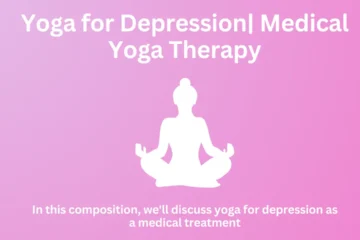As a yoga beginner, I also don’t know what yoga therapy has been like in the past. Or does yoga work as therapy? I have read many research articles on yoga as a medical therapy. Many doctors use yoga to treat diseases. In this era, yoga is used as a medical practice. Let’s start reading more about yoga. As a beginner, you don’t know what yoga therapy is or how it works as a therapy to treat diseases. The goal of yogic practices is to increase well-being rather than treat sickness.
There is no mention of therapeutic or curative purposes in the old Patanjali Yoga Darshan book. Those who suffer from physical or mental illnesses should not discount the potential benefits of yoga as a treatment for a variety of conditions. Yoga may attract more practitioners if it is marketed as a therapeutic tool and people are informed about its potential to produce long-lasting health benefits without having negative side effects. In this blog post, we will discuss how medical yoga therapy manages medical disease.
Thinking About Medical Yoga Therapy
Human populations are seeing an increase in physical and mental disorders as a result of modern lifestyle choices and activities. When traditional medical treatments are not working, yoga may be a useful tool for encouraging recovery. A rising number of people are experiencing psychosomatic disorders, and if given the right treatment, many of them will turn to yoga for healing.
Since the fundamental goals of yoga and yogic practices are the same, the yoga educator may be extremely helpful in shifting the focus of yoga to that of a therapeutic medium. Good results compel people to include yoga in their lives, and many who have been treated for and recovered from illnesses go on to become devoted practitioners and instructors.
Yoga As Medical Therapy Way
The use of yoga techniques to cure diseases, conditions, or problems that arise in any organ system or area of the body is known as yoga therapy. It aims to treat illnesses caused by malfunctions in body parts and systems. Since yoga therapy, also known as yogopathy, was created for therapeutic purposes, it differs fundamentally from other forms of medicine. The unification of the mind, body, and spirit with the Almighty, the Infinite, or the Divine is the ultimate aim of yoga.
Many people’s illnesses have been treated through the years by practicing yoga. Yoga is meant to be a guide for normalcy and harmony, not treatment so that our bodies, thoughts, and spirits can truly be vehicles for the liberation of our souls. Yoga complements medical therapy in some conditions, including diabetes, hypertension, and asthma by lowering the need for medication and enhancing resistance and general health. Yoga may be beneficial in certain situations, but not always in the later phases.

Yoga A Way of Ceasing Diseases
The following are the eight elements of yoga:
1. Yamas (self-restraints)
2. Niyamas (fixed observances)
3. Asanas (posture)
4. Pranayama (breath regulation)
5. Pratyahara (abstraction)
6. Dharana (concentration)
7. Dhyana (contemplation)
8. Samadhi (deep and devout meditation)
The goal of yoga is to unite the individual soul with the Supreme Soul. Self-control in one’s conduct toward oneself and society is the first stage. Yoga establishes a direct connection between the mind and body, paving the way for a mind that is clear and a body that is well. The body and mind can unite through the first four limbs of Kriya Yoga.
It eliminates the core causes of imbalance and keeps the body and mind in a balanced condition. Yoga teaches the body and mind to stay balanced even in unbalanced and unsettling situations, allowing for a swift return to equilibrium and the condition of nature. Yoga speeds up the process of returning the body and mind to their original condition and preserving equilibrium. Diseases arise when there is an imbalance in the internal system.
Yogic Methods for Healing Body & Mind
To get rid of sickness and heal the harm it has caused, one must practice yogic techniques such as asanas, purification, breathing exercises, and meditation. These procedures help restore physical and mental equilibrium by eliminating the disease’s fundamental cause in addition to its symptoms.
1. Asanas
Movement, stability, and relinquishing the pose are all components of asanas. They enhance muscular tone, strength, and flexibility. Extended periods of stability improve blood circulation and efficiency. Certain poses stimulate the endocrine glands, which benefits general well-being. Yoga, cleaning, breath control, and contemplation can help achieve illness independence and body-mind balance.

2. Procedures for Cleaning
For optimum health and illness prevention, Hatha Yoga places a strong emphasis on internal cleaning procedures. It entails several yogic purification techniques, such as “Naadishuddhi,” which clears obstructions from the Naadis to promote healthy circulation and ward against illness. By cleaning thousands of Naadis, these air- or water-based cleansing procedures seek to regulate the autonomic nervous system and treat illnesses.
3. Considering
Through the reduction of mental imbalances and the promotion of mental stability, contemplation is a gentle activity that can aid in the healing of ailments. It promotes mental tranquility, sharpens focus, and lessens pain sensitivity. Frequent practice strengthens mental and physical resilience, enabling recovery from psychosomatic illnesses. Studies reveal that contemplation activates brain areas that support control over mental and physical functions. It also increases consciousness of spiritual energy and strength.
4. Breath Regulation
By fostering mental stability and lowering mental imbalances, contemplation is a peaceful technique that can aid in the healing of illnesses. It brings about mental peace, sharpens focus, and lessens pain sensitivity. Frequent practice improves resistance in the body and mind, enabling recovery from psychosomatic illnesses. Studies reveal that thought stimulates brain regions that support mental and physical regulation. It also brings spiritual energy and strength into sharper focus.
Conclusion
Yoga therapies combine contemporary remedial styles with the age-old wisdom of yoga to provide a comprehensive approach to health and heartiness. The yoga remedy addresses the interdependence of the mind, body, and spirit and enables people to develop tone mindfulness, tone regulation, and tone-care practices that ameliorate their quality of life in general.
Improved tone—mindfulness, emotional resiliency, and a stronger sense of inner balance and tranquility are all pointers to emotional well-being. If you ever feel confused or need guidance, reach out to us through our contact form. I wish you a fulfilling and perfect yoga experience ahead!



0 Comments